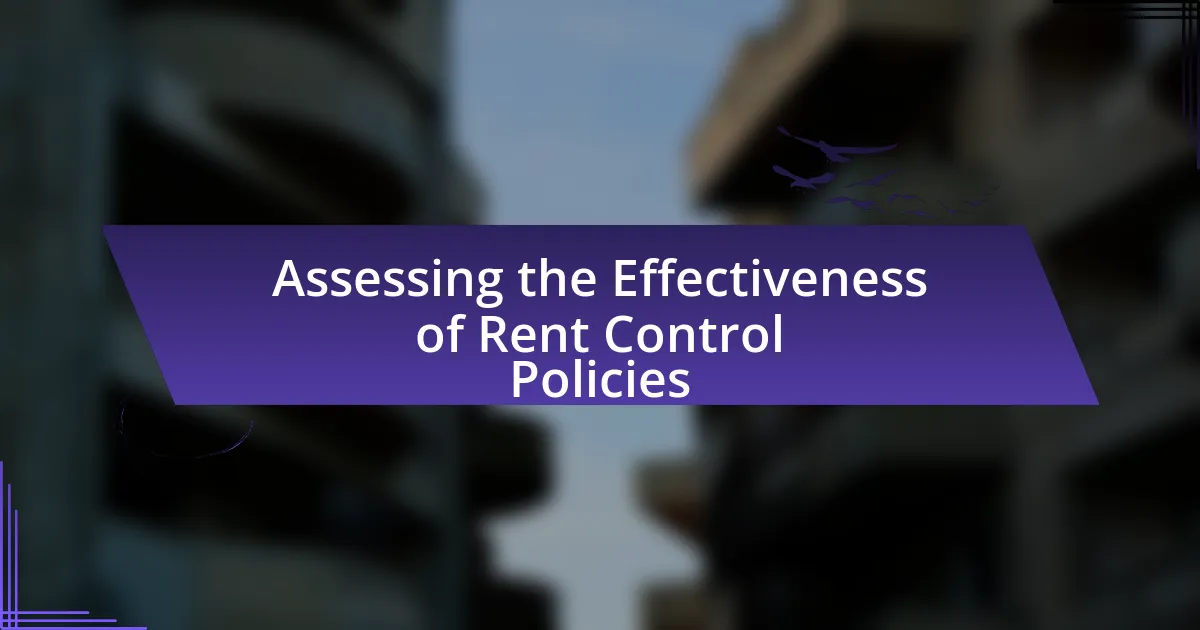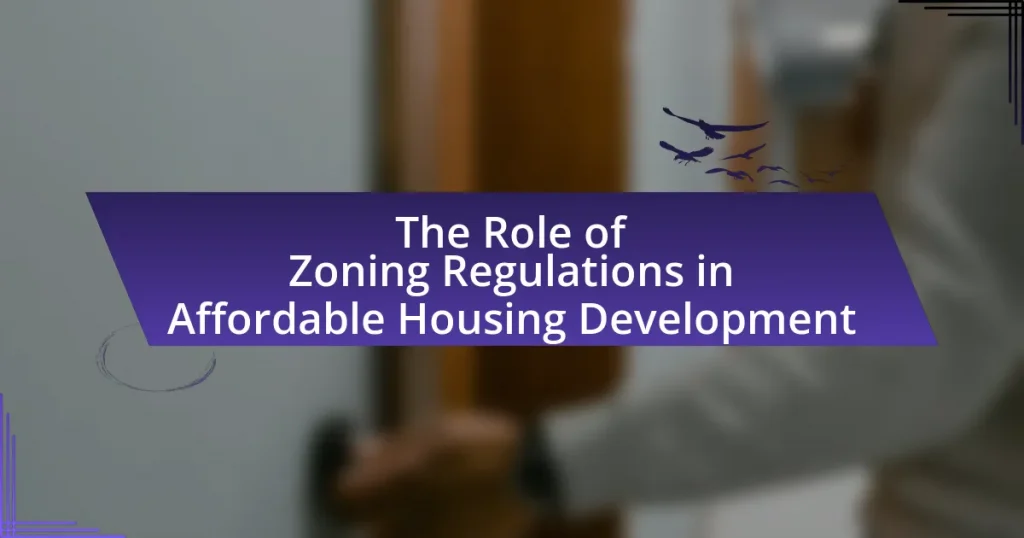Rent control policies are regulations designed to limit the rental prices landlords can charge for residential properties, aiming to enhance housing affordability and stability for tenants. This article evaluates the effectiveness of these policies, examining their components, objectives, and the economic factors they address. It discusses how rent control can protect tenants from displacement while also highlighting the unintended consequences, such as reduced housing supply and property maintenance issues. Additionally, the article explores various types of rent control policies, their regional variations, and best practices for balancing tenant protections with housing availability.

What are Rent Control Policies?
Rent control policies are regulations that limit the amount landlords can charge for renting out residential properties. These policies aim to make housing more affordable for tenants by capping rent increases and providing stability in rental markets. For instance, cities like New York and San Francisco have implemented rent control measures to protect low- and middle-income residents from rapid rent hikes, which can lead to displacement. Studies have shown that rent control can help maintain diverse communities and prevent homelessness, although critics argue it may reduce the overall supply of rental housing.
How do Rent Control Policies function in housing markets?
Rent control policies function by setting limits on the amount landlords can charge for rental units, thereby stabilizing housing costs for tenants. These policies aim to protect low- and moderate-income households from rising rents, particularly in high-demand urban areas. For instance, cities like New York and San Francisco have implemented rent control to prevent displacement of long-term residents. Research indicates that while rent control can provide immediate relief to tenants, it may also lead to reduced investment in rental properties and a decrease in the overall housing supply, as landlords may convert units to non-rental uses or neglect maintenance. A study by the National Bureau of Economic Research found that rent control can lead to a 15% reduction in the rental housing stock over time, highlighting the complex trade-offs involved in such policies.
What are the key components of Rent Control Policies?
The key components of Rent Control Policies include rent stabilization, tenant protections, and regulatory oversight. Rent stabilization limits the amount landlords can increase rent annually, often tied to inflation rates or a fixed percentage. Tenant protections prevent unjust evictions and ensure lease renewals, safeguarding tenants from sudden displacement. Regulatory oversight involves government agencies monitoring compliance with rent control laws, ensuring that landlords adhere to established guidelines. These components collectively aim to maintain affordable housing and protect tenants’ rights in high-demand rental markets.
How do these components influence rental prices?
Components such as location, property condition, and market demand significantly influence rental prices. Location affects desirability; properties in urban centers or near amenities typically command higher rents. Property condition, including age and maintenance, directly impacts perceived value; well-maintained properties attract higher offers. Market demand, influenced by economic factors and population growth, dictates price fluctuations; for instance, a surge in demand during a housing shortage can lead to increased rental rates. These factors collectively shape the rental landscape, demonstrating their critical role in determining prices.
What are the objectives of implementing Rent Control Policies?
The primary objective of implementing rent control policies is to stabilize housing costs for tenants and prevent excessive rent increases. These policies aim to protect low- and moderate-income households from displacement due to rising rents, ensuring affordable housing availability. Historical data shows that cities with rent control, such as New York and San Francisco, have sought to maintain diverse communities and prevent homelessness by limiting rent hikes to a certain percentage, often tied to inflation rates. This approach is intended to create a more equitable housing market and promote long-term tenancy stability.
How do Rent Control Policies aim to protect tenants?
Rent control policies aim to protect tenants by limiting the amount landlords can increase rent, thereby ensuring housing affordability. These policies often establish a maximum allowable rent increase percentage, which helps prevent sudden and excessive rent hikes that could displace tenants. For example, in cities like New York, rent stabilization laws restrict annual rent increases to a set percentage determined by the Rent Guidelines Board, which has historically kept increases below inflation rates. This regulatory framework provides tenants with a degree of financial security and stability in their housing situation, reducing the risk of homelessness and displacement.
What economic factors do Rent Control Policies address?
Rent control policies primarily address housing affordability and market stability. These policies aim to limit rent increases, making housing more accessible for low- and middle-income tenants, thereby reducing the risk of displacement due to rising costs. Historical data from cities with rent control, such as New York, shows that these policies can help maintain diverse communities by preventing rapid gentrification and ensuring that long-term residents can afford to stay in their neighborhoods. Additionally, rent control can influence the supply of rental units, as landlords may be less incentivized to invest in or maintain properties if they cannot adjust rents to market levels, which can lead to a decrease in overall housing quality.

How effective are Rent Control Policies in achieving their goals?
Rent control policies are moderately effective in achieving their goals of providing affordable housing and stabilizing rent prices. Studies indicate that while these policies can temporarily reduce rent increases and protect existing tenants from displacement, they often lead to unintended consequences such as reduced housing supply and decreased investment in rental properties. For instance, a study by the National Bureau of Economic Research found that cities with strict rent control experienced a significant decline in the availability of rental units, as landlords converted properties to condominiums or withdrew them from the rental market altogether. Additionally, the same research highlighted that rent control can lead to a misallocation of housing resources, where long-term tenants occupy units that may not match their current needs, further exacerbating housing shortages.
What evidence exists regarding the impact of Rent Control Policies on housing availability?
Evidence indicates that Rent Control Policies generally reduce housing availability. Studies show that these policies can lead to a decrease in the overall supply of rental units, as landlords may convert rental properties to other uses or reduce investment in maintenance and new construction. For instance, a study by the National Bureau of Economic Research found that rent control in San Francisco resulted in a 15% reduction in the rental housing stock over a decade. Additionally, research published in the Journal of Economic Perspectives highlights that rent control can create a mismatch between supply and demand, leading to longer waiting times for available units and increased market rents for uncontrolled units.
How do Rent Control Policies affect the supply of rental units?
Rent control policies typically reduce the supply of rental units. By capping rent increases, these policies discourage landlords from investing in property maintenance and new construction, leading to a decline in the overall availability of rental units. For instance, a study by the National Bureau of Economic Research found that cities with strict rent control experienced a significant decrease in the number of rental units over time, as landlords opted to convert rental properties into condominiums or other uses that are not subject to rent control. This evidence illustrates that while rent control aims to make housing more affordable, it can inadvertently lead to a tighter rental market.
What are the long-term effects of Rent Control Policies on housing markets?
Long-term effects of rent control policies on housing markets include reduced housing supply, decreased investment in rental properties, and potential deterioration of housing quality. Rent control limits landlords’ ability to increase rents, which can lead to a disincentive for property maintenance and new construction. For instance, a study by the National Bureau of Economic Research found that cities with strict rent control experienced a significant decline in housing stock, with estimates suggesting a reduction of up to 15% in available rental units over several decades. Additionally, the lack of profitability can deter developers from investing in new housing projects, exacerbating housing shortages and increasing market prices for uncontrolled units.
What are the unintended consequences of Rent Control Policies?
Unintended consequences of rent control policies include reduced housing supply, deterioration of rental properties, and increased discrimination against potential tenants. Rent control often leads landlords to convert rental units into condominiums or to withdraw them from the rental market entirely, resulting in a decrease in available housing. For instance, a study by the National Bureau of Economic Research found that cities with strict rent control experienced a significant decline in rental housing stock. Additionally, landlords may neglect maintenance and improvements on controlled units, leading to a decline in property conditions, as they cannot charge market rates to recoup costs. Furthermore, rent control can incentivize landlords to be selective in tenant choices, potentially leading to discriminatory practices against certain demographics, as they may prefer tenants who are less likely to cause issues or who can pay higher rents in the future.
How do Rent Control Policies influence landlord behavior?
Rent control policies significantly influence landlord behavior by limiting the amount landlords can charge for rent, which often leads to reduced investment in property maintenance and upgrades. When landlords face restrictions on rent increases, they may prioritize short-term financial stability over long-term property improvements, resulting in a decline in housing quality. Research from the National Bureau of Economic Research indicates that cities with stringent rent control laws often see a decrease in the overall housing supply, as landlords may convert rental units to non-rental uses or withdraw them from the market entirely. This behavior is driven by the need to offset the financial constraints imposed by rent control, ultimately affecting the availability and quality of rental housing.
What impact do Rent Control Policies have on property maintenance and quality?
Rent control policies generally lead to a decline in property maintenance and quality. When landlords face restrictions on rent increases, their revenue potential diminishes, which can result in reduced financial resources for property upkeep. A study by the National Bureau of Economic Research found that rent-controlled buildings often experience lower levels of maintenance compared to non-controlled units, as landlords may prioritize profit over investment in property improvements. Consequently, tenants in rent-controlled properties may face deteriorating living conditions, impacting overall housing quality.

What are the different types of Rent Control Policies?
The different types of rent control policies include rent stabilization, rent control, and vacancy control. Rent stabilization typically limits the amount landlords can increase rent annually, often tied to inflation rates, while allowing for some flexibility in rent increases. Rent control, on the other hand, sets a maximum rent that landlords can charge, often resulting in lower rents for tenants but potentially leading to reduced housing supply. Vacancy control restricts rent increases even when a unit becomes vacant, maintaining lower rents for new tenants. These policies aim to protect tenants from excessive rent hikes and ensure affordable housing, but they can also lead to market distortions and reduced investment in rental properties.
How do different Rent Control Policies vary across regions?
Rent control policies vary significantly across regions in terms of their regulations, enforcement mechanisms, and impact on housing markets. For instance, in New York City, rent control is characterized by strict regulations that limit rent increases and provide tenant protections, while in California, the statewide rent control law allows for annual rent increases capped at 5% plus inflation, with local jurisdictions having the authority to implement stricter rules. Additionally, cities like San Francisco have their own unique rent control ordinances that include provisions for vacancy control, which prevents landlords from raising rents significantly when a unit becomes vacant. These variations reflect local housing market conditions, political climates, and social priorities, demonstrating that the effectiveness of rent control policies can differ widely based on regional implementation and context.
What are the common types of Rent Control Policies implemented globally?
Common types of rent control policies implemented globally include rent stabilization, rent control with vacancy decontrol, and rent regulation. Rent stabilization typically limits the amount landlords can increase rent annually, often tied to inflation rates, as seen in cities like New York. Rent control with vacancy decontrol allows landlords to set new rents at market rates once a tenant vacates, which is practiced in various jurisdictions. Rent regulation encompasses broader measures that may include limits on rent increases and tenant protections, commonly found in countries like Germany and Sweden. These policies aim to maintain affordable housing and protect tenants from sudden rent hikes.
How do local regulations shape the effectiveness of Rent Control Policies?
Local regulations significantly influence the effectiveness of rent control policies by determining the specific rules and enforcement mechanisms that govern rental markets. For instance, regulations can dictate the allowable rent increases, the types of properties covered, and the procedures for tenant eviction. In cities like San Francisco, stringent rent control laws have been linked to reduced tenant displacement, while in other areas with less rigorous regulations, such as Houston, the absence of rent control has led to increased housing instability. Studies show that effective local regulations can mitigate the negative impacts of rent control, such as reduced housing supply, by ensuring that landlords can still maintain their properties financially.
What lessons can be learned from case studies of Rent Control Policies?
Case studies of rent control policies reveal that while they aim to provide affordable housing, they often lead to unintended consequences such as reduced housing supply and deterioration of rental properties. For instance, a study on New York City’s rent control system indicated that rent-controlled apartments decreased in number over time, as landlords opted to convert units to market rates or withdraw them from the rental market altogether. Additionally, research from the National Bureau of Economic Research found that rent control can discourage new construction, leading to a long-term housing shortage. These findings underscore the complexity of implementing rent control and highlight the need for careful consideration of its economic impacts.
What successful examples of Rent Control Policies exist?
Successful examples of rent control policies include New York City and San Francisco. In New York City, rent stabilization laws have been in place since the 1940s, allowing tenants to remain in their homes while limiting rent increases to a set percentage each year, which has helped maintain affordable housing for millions. In San Francisco, the rent control ordinance enacted in 1979 has similarly protected tenants from excessive rent hikes, contributing to the preservation of diverse communities despite rising property values. Studies indicate that these policies have effectively reduced displacement rates and maintained housing stability in these urban areas.
What failures or challenges have been documented in Rent Control Policies?
Rent control policies have documented failures and challenges, primarily including reduced housing supply and deterioration of rental properties. Studies indicate that rent control can lead to landlords withdrawing units from the rental market, as seen in cities like San Francisco, where a 2018 study found that rent control reduced the rental housing stock by approximately 15%. Additionally, properties under rent control often experience less maintenance and investment, leading to a decline in housing quality, as evidenced by research from the National Bureau of Economic Research, which highlights that rent-controlled units are less likely to be renovated compared to market-rate units. These challenges illustrate the unintended consequences of rent control policies on housing availability and quality.
What best practices can be adopted for effective Rent Control Policies?
Effective rent control policies should incorporate a balanced approach that includes clear regulations, regular adjustments for inflation, and tenant protections. Establishing a transparent framework for rent increases, such as linking them to the Consumer Price Index, ensures that rents remain affordable while allowing landlords to maintain their properties. Additionally, implementing tenant protections against eviction and harassment fosters stability in housing markets. Research indicates that cities with well-structured rent control measures, like San Francisco, have managed to maintain a diverse population while preventing displacement, demonstrating the effectiveness of these practices.
How can policymakers balance tenant protection and housing supply?
Policymakers can balance tenant protection and housing supply by implementing targeted rent control measures that prevent displacement while incentivizing new construction. For instance, policies that allow for rent increases tied to inflation can protect tenants from sudden price hikes while ensuring landlords can maintain profitability. Additionally, offering tax incentives or subsidies for developers to build affordable housing can increase supply without compromising tenant rights. Research indicates that cities with moderate rent control combined with incentives for new housing development have seen a more stable rental market, demonstrating that a balanced approach can effectively address both tenant needs and housing availability.
What strategies can enhance the effectiveness of Rent Control Policies?
Implementing targeted exemptions for new constructions can enhance the effectiveness of rent control policies. By allowing developers to build new housing units without the constraints of rent control, cities can increase the overall housing supply, which can alleviate pressure on existing rental markets. For instance, a study by the National Bureau of Economic Research found that cities with flexible rent control policies that included exemptions for new developments experienced a 10% increase in housing supply, leading to a decrease in rental prices over time. Additionally, incorporating regular adjustments for inflation within rent control regulations ensures that landlords can maintain property standards while still providing affordable housing options.



